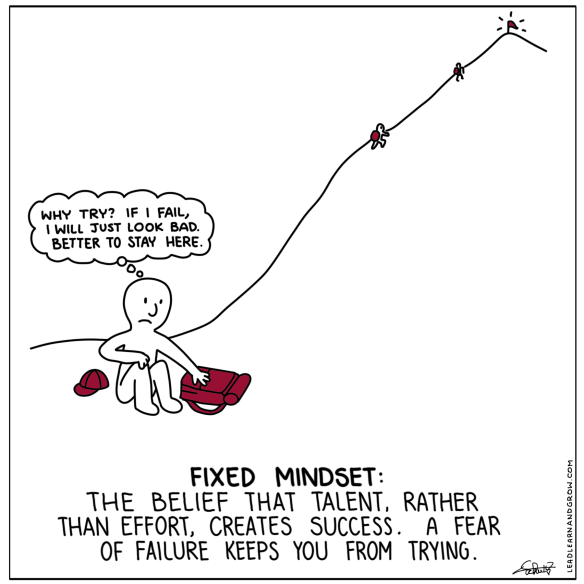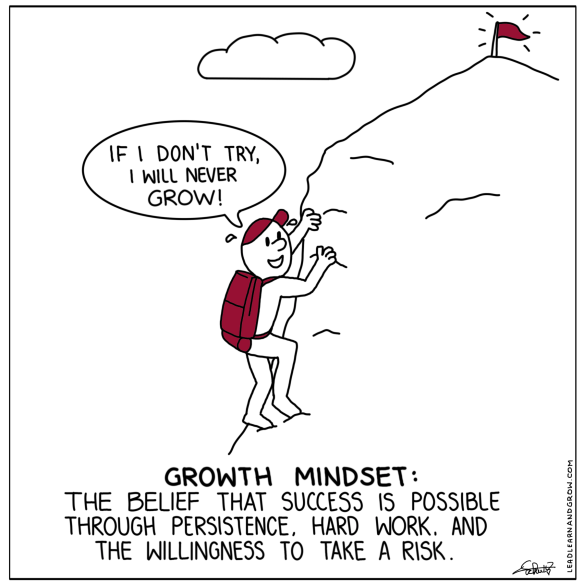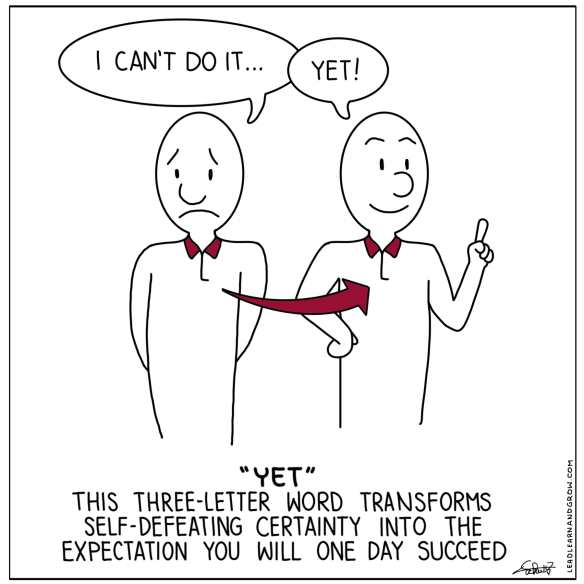In the previous chapter, we explained what it means to lead yourself. We shared four skills you can develop to lead yourself more effectively. In this chapter, we will focus on the second of those four skills: building resilience and cultivating a “growth mindset”.
Let’s begin by defining resilience. Resilience is the ability to recover quickly from a setback. It is the “elasticity’ that lets you quickly spring back into shape when you stumble, fall or fail. As an English idiom goes, you need to get back up on the horse that knocked you off.

What are some examples of when you might need resilience? In your personal life, you might receive a poor grade on a test or a paper, you might be rejected by a romantic partner or hurt by a friend, or you might struggle to learn a new language or master a new skill.
In your work life, you may receive feedback that your output doesn’t yet meet expectations, you may encounter interpersonal conflicts with colleagues, you may receive less of a raise than you expected, or you may be laid off in a corporate restructuring.
In all of these examples – as well as many more – resilience is important to develop.
Why is resilience an important skill to develop? Even the most successful people fail – sometimes much more often than they succeed! There is the story that Thomas Edison tried 1,000 variations on the incandescent light bulb before he landed on the successful formulation.
Michael Jordan, perhaps the greatest basketball player in history, is quoted as saying, “I’ve missed more than 9,000 shots in my career. I’ve lost almost 300 games. Twenty-six times I’ve been trusted to take the game-winning shot and missed. I’ve failed over and over and over again in my life. And that is why I succeed.”
The lesson here, is that even the most successful people fail and they may end up being successful because they develop resilience.
There is another reason resilience is important: the world is changing at an ever-faster pace. You will have to learn more new skills, more quickly, than did the generation before you. If you know you will have to learn a lot, you can expect that you will face many failures and setbacks along the way. The greater your resilience, the better you will be able to adapt and thrive in the ever-changing world.
What are some specific ways you can develop resilience? The most effective way to develop resilience is to cultivate a growth mindset. More about what that means in a moment. First, let’s consider this observation:
How you noticed this interesting tick of human behavior? When we are successful at something, we tend to credit our knowledge, skill or ability. And when we fail at something, we tend to find an external reason to blame: didn’t have enough time, the instructions were unclear, we didn’t have our coffee this morning, etc.. This is called “attribution bias” and because of it, we tend to try to explain away failure, rather than owning it and figuring out how to learn from it.

To develop resilience, we have to do something very uncomfortable: we need to learn to embrace failure. That may sound crazy, but as we shared earlier, even the most successful people in their fields fail often. If you know that failure is inevitable, why not embrace it and learn from it?
The best way to do this is to cultivate a “growth mindset”. A mindset is a self-perception that people hold about themselves. Believing that you are either “intelligent” or “unintelligent”, “creative” or “not creative” are simple examples of mindsets.
People can be aware or unaware of their mindsets, which can have profound effects on learning achievement, personal relationships and professional success. Psychologist Carol Dweck did a lot of research looking at how people’s mindsets affect their achievement. She coined the terms “growth mindset” and its opposite, “fixed mindset”.
In a fixed mindset, people believe their basic qualities, like their intelligence or talent, are simply fixed traits. They believe that talent alone creates success – without effort. People with a fixed mindset (for example, the belief that I am “smart” or “dumb” and this cannot be changed) may learn less than they could and shy away from challenges.

When people with fixed mindsets fail at something, they may tell themselves they can’t or won’t be able to do it or they make excuses to rationalize the failure. Sound familiar?
Here’s a quick example: consider someone playing a word or number game like a crossword puzzle or Sudoku. After finishing one of these puzzles, a person with a fixed mindset is likely to choose to do another that is at the same level of difficulty, because they know they can successfully complete that level of puzzle.
In a growth mindset, people believe that their most basic abilities can be developed through dedication and hard work—brains and talent are just the starting point. People who embrace growth mindsets (the belief that they can become better if they work hard and persevere) may learn more quickly and view challenges and failures as opportunities to improve their learning and skills.

When people with growth mindsets fail at something, they look at the failure as a lesson. They try to figure out what they could try differently and then actively apply what they learned to the next attempt.
Back to the Sudoku example, when completing a puzzle, someone with a growth mindset is likely to choose to attempt a puzzle of greater difficulty. They are excited by the challenge and seek to test – and push – their limits.

Here are four easy ways to cultivate a growth mindset and, by doing so, increase your resilience:
- Add the word “yet” to your vocabulary. Notice the subtle difference between these two phrases: “I can’t speak in public” and “I can’t speak in public yet.” With the addition of a three-letter word, “yet”, you transform a self-defeating certainty into an expectation that you can one day achieve the goal. It may sound silly, but language dictates mindset. Try adding the word “yet” when you describe something you cannot do or are not comfortable doing and see how it changes you.
- Expect to learn from every experience. We all agree that when you have not succeeded, there are obviously lessons you can learn. But even when you succeed, there are still lessons you can learn. If you look at every experience as a learning opportunity, it will matter less whether you succeed or fail – your goal is to learn and continue to improve. World-class athletes continue to look for ways to improve, even when they have won the game or set a new record. You, too, can seek to learn from every experience by asking yourself afterwards: “What did I do well?” and “How could I do better next time?”
- Ask others about the lessons they learned the hard way. While you may think that your manager or other people in the organization are flawless and perfect (actually, you don’t really think that, do you?), they have made mistakes along the way like everyone else. Strike up a conversation with them and ask about the biggest lessons they have learned in their career – and ask whether the lessons more often came from success or from failures. These type of conversations increase trust and offer valuable insights that all of us are learning from failure.
- Finally, take the long view: five, ten, or twenty years from now, will you remember this “failure”? Probably not – and if you get back up and try again, you’ll likely remember this “failure” as the moment that inspired you to try again and succeed. The pain and frustration of failure fades quickly from our memories, and a hard-earned success tastes particularly sweet!
As you can see, there are very practical ways to practice strengthening your resilience. Your exercise for this chapter: choose one of those actions and practice it throughout the week. Reflect on how your practice goes and, remember, you will learn from the setbacks and failures as well as from the successes.
In the next chapter,we will look at the “lead yourself” skill of focusing on what you can do rather than what you cannot do.
As always, we welcome your input and feedback: leave your comments below or drop us a message.
Return to the title page
Previous chapter: Leading yourself
Featured photo by Dulcey Lima on Unsplash
